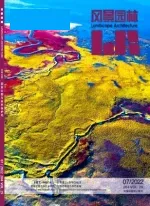刊首语
刊首语

文化景观的概念虽始于19世纪末,但它早已在人类漫长的演进历程中悄然形成。
自人类繁衍于一片土地开始,文明便在这片土地上孕育孵化,被赋予地域色彩的文化也随即在人与土地共养生息的过程中落地生根,经岁月的洗礼,文化景观从地域中衍生而成,记录着人与土地的亲密关系,反映着他们之间一种最持久的联系。
土地是人类活动最坚实的舞台,它无处不在,地球上几乎大部分土地都留下了人类干预的痕迹,因此呈现出多元化的文化景观是各个国家的国土景观中占地面积最广阔的组成,特别是在已有5 000年历史,国土面积辽阔,人口众多的中国。
在前工业时期,出于生存本能,人类在土地上进行最直接的大面积开发活动即是农业耕种,随之形成的农业景观便成为文化景观的本源,这一说法在西方的拉丁语“culture”一词中可得印证。该词最原初的意思指“耕作、开垦或耕作农业”,后在英语中逐步引申至“对人的教化、集体智慧的结晶”,遂形成“文化”的含义。可以说,文化景观主要指的就是“第二自然”,即生产的自然,或者说是劳作的自然,或经过生产而改变的自然。
“人与自然”、“人工干预”、“景观叠加”等是解读文化景观内涵的关键。文化景观是历史长河中,人类与自然之间在经济、文化和社会等因素驱动下,相互影响并紧密结合的共同杰作,并随着人类活动的作用而不断变化,能深刻反映出人类与自然之间的和谐进化历程。
在一系列人工干预自然的过程中不断改变,千百年后,呈现在人们面前的文化景观是一个对地表不断复写,由不同时期的景观逐步融合而成的结果。换言之,它是人类为满足实际生存、生产、生活需要,以特定地域文化为主体,以自然环境为媒介,在基于土地的自然景观之上逐步叠加人工景观而形成的地表综合体。
文化景观的营造与形成并不一定是人们有意为之,也并非是满足纯粹的欣赏需求或有意识地要为后世留下景观遗产,它是反映特定时期人生活状态的最鲜活见证,亦是体现“人与天调”的最佳力证。
文化景观遗产是当代的人们为这些国土上广泛存在的文化景观赋予评价体系和价值体系的标记方式,以更好的保留保护使其得以永续。某种意义上说,无论如何客观的制定评价体系,也无法摆脱被当代人的审美与价值观所左右。而面对的评价对象却是人类千百年来对土地的重写而呈现的风貌。
文化景观遗产是文化景观的一部分,而不论人们评价与否,文化景观就在那里,显而易见的是,无论我国北方的村落抑或江南的水乡都是人们最为知悉的文化景观,尽管他们并没有列入文化景观遗产的名录。
要用长远的眼光看待保护和发展文化景观的问题,文化景观是基于生存形成的,而维系它的根本是使其依然能体现当下人们的生存方式,使其永葆活力。唯如此,文化景观才能向着永续的方向发展,这也是本期《风景园林》的主题。
刊首语
Although the concept of cultural landscape begins at the late 19th century, it had already existed over the course of gradual progress of human development before the 19th century.
Since human appeared on this piece of land, the human civilization developed with great evolution. Culture with regional landscape identity emerges in the interaction between land and human. After decades of years, cultural landscape gradually derive from regional landscape, recording a close relationship between human and the land we live on, and reflecting the everlastingconnection between us.
The land is everywhere on earth, all human activities are based on the land and we have left our trace on almostevery piece of the land on earth. Therefore the largest part of the national landscape is always the distinctive diversified cultural landscape, especially in China, a nation with long history over five thousand years, the vast land area and huge population.
In the pre-industrial age, to survive, human must widely use the land for agricultural activity and farming.In this way, the cultural landscape initially originated from the old agricultural landscape. This could also be proved by the evolution towards a Latin word “culture”.The original meaning of the word “culture” is "farming,cultivation and reclamation". Then, the meaning extendedto "educating people and collective wisdom", initially turned into the concept of "culture" we own today. To some extent, cultural landscape refers to the “second nature”, the productive nature, or the modified nature after human productive interference.
“Human live with the nature”, "human intervention” and “superposition of landscape” are three key points for understanding the cultural landscape. Cultural landscape represents the combined masterpiece of the interaction between nature and human driven by the elements of economy, culture and society. It is constantly influenced by and evolved with human activities, to reflect the bond connection between human and the nature.
Over the course of thousands years of human interference on the process of nature, current cultural landscape we see is the outcome of the overlaid landscape from different periods. To put it in another way, cultural landscape is the comprehensive earth-surface superposing artificial landscape constantly upon the natural landscape, using specific regional culture as the main body, natural environment as the medium, for meeting the need of human survival, producing and living.
But the formation and creation of cultural landscape is not always determined by human. Generally, cultural landscape was not intentionally created for enjoyment or as permanent landscape heritage. It is the vivid witness of the human's living state of specific historical period. It fully communicates “the harmony of man with nature”.
We define cultural landscape heritage as the evaluation system to assess and label cultural landscapes for better protection and further continuation. To some extent, in term of the long history natural landscape, no matter how non-subjective the evaluation system is, our evaluation is more or less affected by contemporary aesthetics and values.
Cultural landscape heritage is a part of the cultural landscape. No matter how people evaluate it, cultural landscape is natural landscape created by long time human culture such as the typical villages in the north of China and well-known Jiangnan Watertown. They are famous cultural landscape in China even if they are not listed as the cultural landscape heritage.
The conservation and development of cultural landscape should be taken long-term vision towards it. Cultural landscape is derived from human life, thus the best way to keep it lasting is to maintain the origin human lifestyle on the landscape. Only in this way could the cultural landscape develop towards sustainability. This issue of Landscape Architecture is exactly based on this topic.
WANG Xiang-rong August 18, 2015

